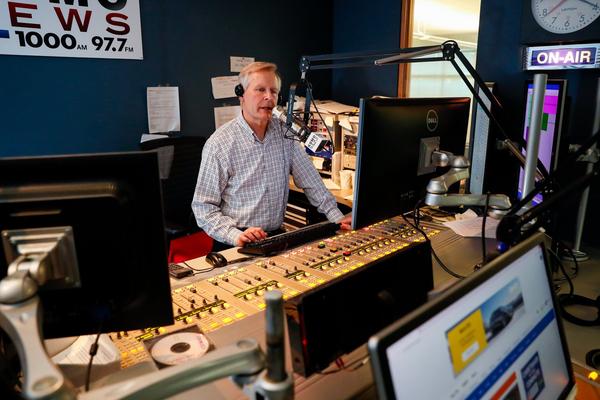Come Wednesday, there’s going to be a major change to one of Seattle’s oldest radio stations.
KOMO Radio, 95 years on the air, 1000 on the AM dial, a brand name associated with such slogans as “You’re in KOMO Country” and “Your Husky station,” isn’t going to be KOMO anymore.
It’s just business. Radio and TV stations get bought and sold all the time.
What happened is that there is KOMO the news and talk radio station, which was sold in May 2021 by the Sinclair Broadcast Group. And there is KOMO the TV station, which Sinclair has kept.
The radio sale did not include the KOMO brand name. A spokesperson for Sinclair had no comment.
KOMO Radio’s new call letters will be KNWN, for “Northwest News.”
“I could have come up with something a little catchier,” says Jason Remington, creator and publisher of the website PugetSound.Media.
You can place yourself in Seattle history with what you remember of the KOMO Radio brand name.
You know, this is the station that from the late 1970s to the early 2000s, then again in the mid-2010s, was the home of Husky football. That’s about as brand name as you can get in the Northwest.
In today’s search-digital-strategic-optimization-marketing-page-views world, a KOMO legacy name counts. There are still plenty of locals who didn’t just arrive to town a couple of years ago.
Some radio fans who’ve heard about the name change have posted their dismay.
“I was born in 1952. For me, it’s just like The Bon or Frederick & Nelson going away, another big name,” says Mike Garland, 69, of Milton, a town near Tacoma. He used to be a utility announcer at various local radio stations, including a stint at KOMO.
Now, he’s an admittedly grumpy old guy posting on Facebook: “For us old timers it’s another end of an era. There are few things sacred in Seattle anymore.”
Sinclair is the Maryland behemoth that owns 185 TV stations across the country. Back in 2013, it paid $373 million to Fisher Communications for KOMO-TV and 19 other television stations.
The conservative company riles up progressives in this blue city. They lambasted the company’s Channel 4 here for its 2019 documentary “Seattle is Dying.”

The 2013 sale included “Newsradio” KOMO-AM and FM, “Star 101.5” KPLZ and “Talk Radio” 570 KVI.
But Sinclair’score business is television, and it sold the radio stations to Lotus Communications of Los Angeles for $18 million in cash and “other consideration.”
Lotus specializes in radio, with 48 stations in the West. On its website the company touts its “vision of producing local programming.”
Meanwhile, KOMO Radio, as it still is called for these next few days, is figuring out a marketing plan, says Rick Van Cise, the program director and afternoon news co-host.
“There won’t be any difference in the sound of the radio station,” he says. “The personalities, the reporters are all staying the same.”
And, really, the only time listeners will hear the new call letters is at the top of the hour, as mandated by Federal Communications Commission rules.
Most Read Local Stories
Paul Heine, managing editor of Inside Radio, an industry site, says that for listeners, “It will initially take some getting used to. A name change can be jarring at first. But if the station is still seen as accurate and trustworthy as a news outlet, over time listeners will understand.”
Casual listeners might not even notice the name change, as even after Wednesdaythey’ll still be hearing the KOMO name on the radio station.
Van Cise says the relationship with KOMO-TV will continue.
The station will air news and other items produced by KOMO-TV, as it does now, he says, and they will be identified as coming from “KOMO 4” or the “KOMO 4 weather center.” Items produced by the radio station, he says, “will go straight to the host” without a station identification.
Sponsored
KOMO Radio has carved out for itself a place among the 30-some Seattle-Tacoma stations, the 12th largest metro market in the country.
The station does this with a format that repeats every hour. There is traffic and weather every 10 minutes.Sports at 10 and 40 minutes past the hour. Money news at 20 and 50 past the hour.
Ages 35 to 64 “is where we find the sweet spot,” says Van Cise. “We generally rate in the top three radio stations,” he says.
Although sometimes terrestrial radio — meaning AM and FM stations — is written off as dead technology, it’s still very much a part of mainstream listening habits. In 2020, 83% of Americans ages 12 and up listened to terrestrial radio in a given week, says Pew Research Center.
The top formats in Seattle radio are some variations of rock or hit music, and news/talk. In our local radio tastes, we go from the Stones to Adele to Dori to those pensive NPR stories.
In the Seattle metro area, in the advertising-coveted 25-44 age group, over a year span ending in August 2021, the top five stations were, in order, KISW (rock), KQMV (hits), KBKS (hits), KUOW (news and talk) and KZOK (classic rock).
In the 35-64 group, the top five stations, were, in order, KIRO-FM, KISW, KZOK, KUOW and KJR-FM (classic hits). In this particular survey, KOMO and KRWM (adult contemporary) are just out of the top 5, with a minute percentage difference.
It’s all incremental in ratings. A No. 5 station has a share of the total listening audience in the low 4%. A No. 1 station has a share in the low 7%.
The mind-numbing details: All rankings are based on a Nielsen Scarborough (Scarborough is a joint venture with Nielsen) study from August 2020 to August 2021, Monday-Sunday, 6 a.m. to midnight, based on the average number of people listening to a particular station for at least five minutes during a 15-minute period.
KOMO Radiofirst went on the air at 3 p.m., New Year’s Eve, 1926.
The programming started off with a live orchestra playing “Stars and Stripes Forever.” The downtown headquarters for the station included a “concert artists’ studio, special speakers’ booth and large studio for bands and orchestras,” The Seattle Times reported.
It was O.D. Fisher, who along with his brother, O.W. Fisher, founded Fisher Flouring Mills in 1911, on Harbor Island, “whose own enthusiasm for radio” resulted in KOMO Radio, said The Times.
It didn’t hurt that the station also helped advertise Fisher’s Blend Flour.
KOMO Radio wasn’t flashy. Loud jocks would have been anathema.
A 1971 ad featured newsman Bryan Johnson, who sounded, looked and acted like a straight-shooting reporter. “KOMO is CONSISTENTLY Seattle’s NUMBER ONE Adult Radio Station because of people like Bryan Johnson,” headlined the ad.
It’s tough for local media ownership to stay local.
When Fisher Broadcasting sold to Sinclair, that was it for the region’s last locally owned network television station, said a June 7, 2013, story in the Puget Sound Business Journal. By 2002, Fisher already had sold the unprofitable flour business.
“That distinction might have held sentimental value for some, but it has little relevance in the modern media landscape, which is increasingly becoming dominated by a handful of national giants,” said the story. Large shareholders in Fisher had put pressure on the board to sell.
For now, KOMO Radio is broadcasting from KOMO Plaza, near Seattle Center, right by the TV side. Eventually it’ll move to a new location, says Van Cise, just as it’ll create a new website for the station, which now is part of the KOMO News site primarily focused on the TV side.
OK, now, quick quiz.
What are the new call letters?




